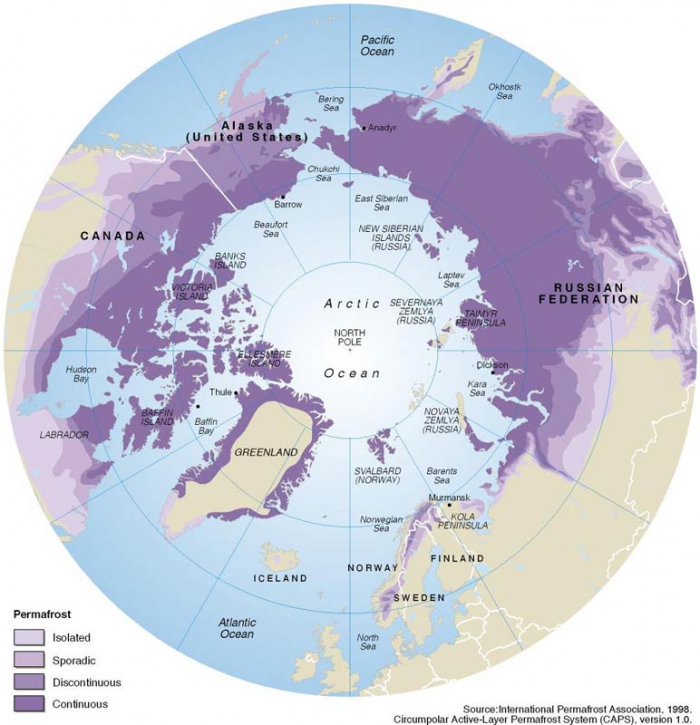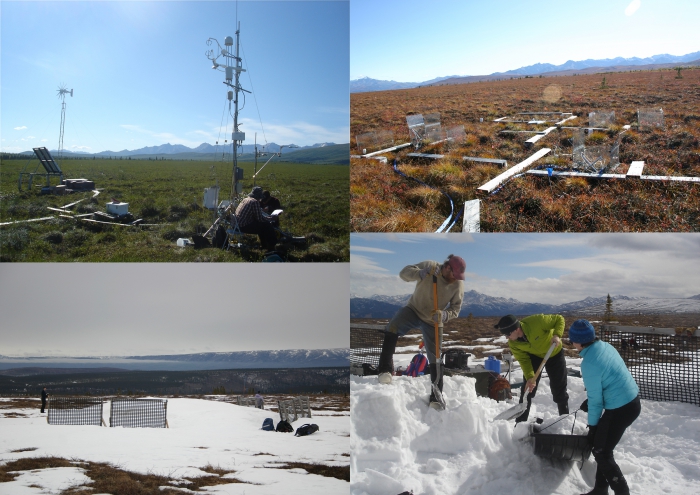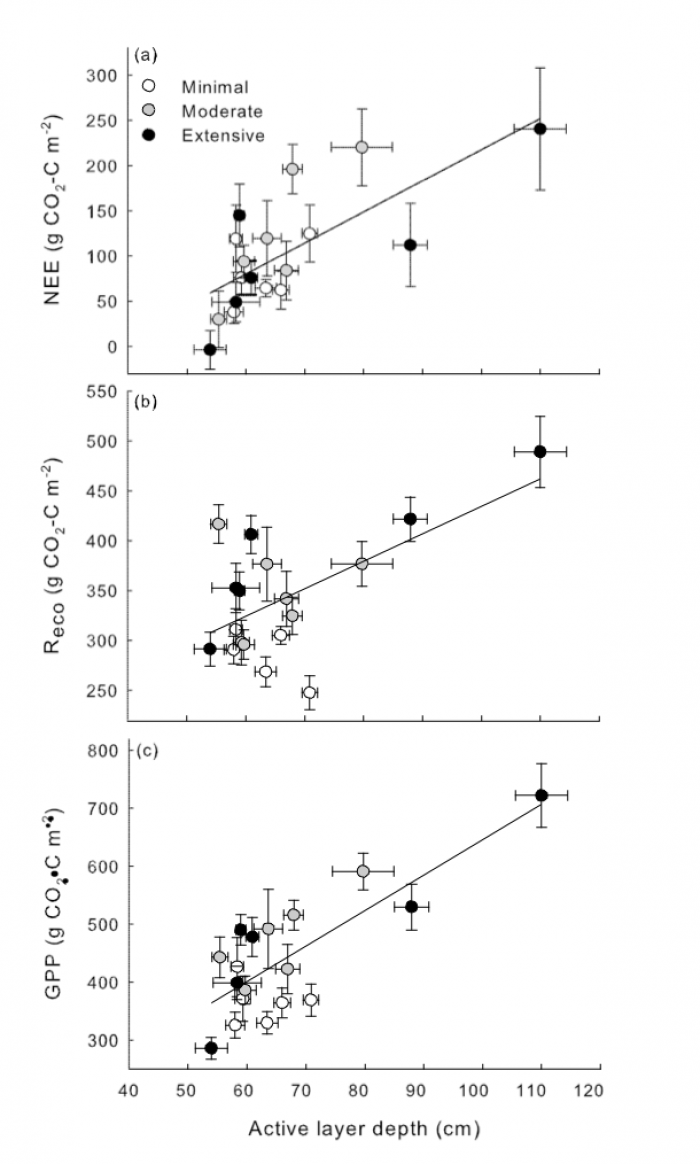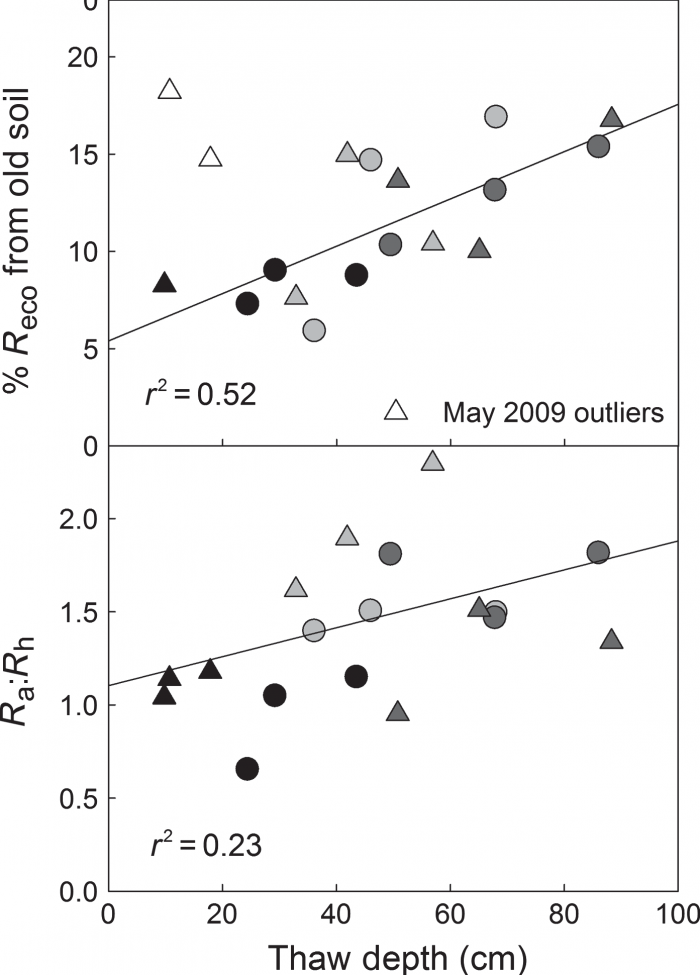By: Marguerite Mauritz, Postdoctoral Researcher at the Center for Ecosystem Science and Society, Northern Arizona University; and Ted Schuur, Professor of Ecosystem Ecology at the Center for Ecosystem Science and Society, Department of Biological Sciences, Northern Arizona University
Overview
Climate change will be felt most strongly in high latitude regions of Earth, with Arctic temperature increases expected to be about two times higher than the global average. As the climate warms, thawing of perennially frozen ground (permafrost) is likely to be an important mechanism for moving significant quantities of stored carbon into the atmosphere. Permafrost stores a third of the carbon found in soils of ecosystems globally. Permafrost carbon has accumulated over thousands of years, protected from microbial decomposition by frozen or waterlogged conditions. Release of just a fraction of this frozen carbon pool into the atmosphere, as greenhouse gases carbon dioxide and methane, could make climate change happen faster than expected.
With climate change, warmer air temperatures causes frozen ground to thaw, which in turn influences the surface water that sits in the soil on the permafrost surface. Environmental changes in both temperature and moisture have the potential to alter plant communities, soil microbial communities, and soil decomposition rates, which together control the storage of ecosystem carbon. How much, how quickly, and in what form carbon (carbon dioxide or methane) is released from permafrost ecosystems controls the feedback from permafrost carbon to climate change. Two central questions address this issue and motivate our research: 1) How does permafrost thaw affect ecosystem carbon storage? and 2) How much of the old carbon that has been frozen for hundreds to thousands of years is being lost in response to warming? Answers to these questions will help inform how Arctic ecosystems will impact the rate of future climate change.

Experimental Site
The Eight Mile Lake (EML) research watershed combines observations and experimental manipulation to understand how warming and permafrost thaw impact ecosystem carbon exchange in an Arctic ecosystem undergoing rapid change. EML is located in Interior Alaska near Denali National Park in the zone of discontinuous permafrost where permafrost temperature already hovers near freezing. The vegetation at the site is moist acidic tundra comprising graminoid sedges (grasslike plants), evergreen and deciduous shrubs, and a moss understory, and is typical across large swaths of the Arctic. At this site, we have established two experimental systems to address the effect of permafrost thaw on ecosystem carbon balance (see Figure 2).
The Permafrost Thaw Gradient represents a gradient in space spanning areas from minimal permafrost thaw to extensive permafrost thaw that has been degrading for decades. Here, we have been monitoring ecosystem carbon exchange since 2003 adjacent to a permafrost borehole that has documented long-term permafrost degradation since 1985. A second manipulative experiment was established in 2008 to complement observations at the Thaw Gradient. We have manipulated air and soil temperatures, and water table at the Carbon in Permafrost Experimental Heating (CiPEHR, 2008) and Drying (DryPEHR, 2011) project in order to isolate the independent effects of changes in temperature and moisture on tundra carbon balance.

How does permafrost thaw affect tundra carbon storage?
Across the Permafrost Thaw Gradient, increased permafrost degradation measured by a thicker active layer (seasonally thawed layer at the soil surface) enhanced carbon loss via microbial and plant metabolism together measured as ecosystem respiration (Reco). At the same time, thaw also increased plant carbon uptake as measured by gross primary productivity (GPP) Similarly, experimentally-induced permafrost thaw at CiPEHR demonstrated that warming rapidly stimulated photosynthesis (GPP) and respiration (Reco) even in the relatively short duration of the manipulation experiment. At both the Permafrost Thaw Gradient and CiPEHR, photosynthesis was stimulated more than respiration in the summer months, with the result that permafrost thaw actually caused more atmospheric carbon to enter the ecosystem than was lost, as measured by positive net ecosystem carbon exchange (NEE) (see Figure 3). Carbon gain during the summer was offset by carbon losses in the winter, when plants are largely dormant but soils are still above-freezing and microbes are active through much of the fall. Non summer season carbon loss offset all the summer gains in the warming manipulation, and even exceeded summer gains at the Permafrost Thaw Gradient making it a net source of carbon to the atmosphere on an annual basis.

Using carbon isotopes (13C and 14C) we can investigate the age of carbon being lost as well as the sources (plants, soil), and begin to understand the mechanisms of ecosystem carbon storage. Carbon isotope data has revealed that increased permafrost thaw stimulates the contribution of old carbon to ecosystem respiration (see Figure 4). This means that carbon trapped in permafrost for long periods of time can become available for microbial decomposition once thawed. This old carbon release to the atmosphere is what depletes the permafrost carbon pool and accelerates climate change.

Future directions
Continued measurements of ecosystem carbon exchange at both the Permafrost Thaw Gradient and the CiPEHR/DryPEHR warming experiment will be important for quantifying the long-term impact of permafrost thaw on carbon emissions to the atmosphere. Our expectation for the warming manipulation is that the plant productivity response will level off sooner than the microbial response, meaning that the summertime carbon sink may decrease over time. Additionally, new observations of methane at the Permafrost Thaw Gradient will reveal the importance of this greenhouse gas in response to hydrologic changes that accompany permafrost thaw. Because methane has a much higher warming potential than carbon dioxide, shifts in the release of these two gases will influence the net effect of permafrost carbon emission on climate change.
Selected References
Hicks Pries, C. E., Schuur, E. A. G. & Crummer, K. G. Thawing permafrost increases old soil and autotrophic respiration in tundra : Partitioning ecosystem respiration using d 13 C and 14 C. Glob. Chang. Biol. 19, 649–661 (2013).
Natali, S. M., Schuur, E. A. G., Webb, E. E., Pries, C. E. H. & Crummer, K. G. Permafrost degradation stimulates carbon loss from experimentally warmed tundra. Ecology 95, 602–608 (2014).
Schuur, E. A. G. et al. The effect of permafrost thaw on old carbon release and net carbon exchange from tundra. Nature 459, 556–559 (2009).
Schuur, E. A. G. et al. Climate change and the permafrost carbon feedback. Nature 520, 171–179 (2015).
Trucco, C. et al. Seven-year trends of CO2 exchange in a tundra ecosystem affected by long-term permafrost thaw. J. Geophys. Res. Biogeosciences 117, 1–12 (2012).
